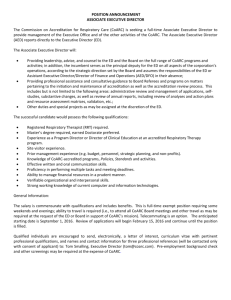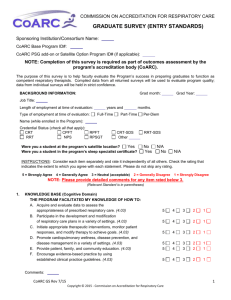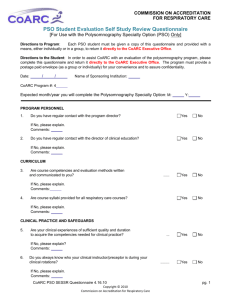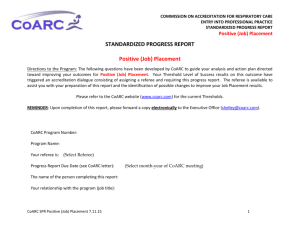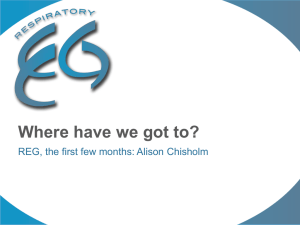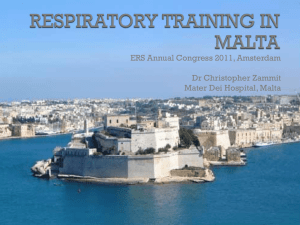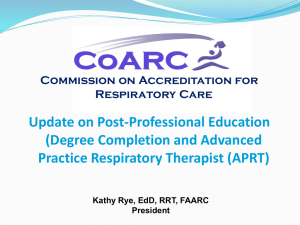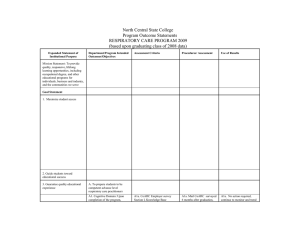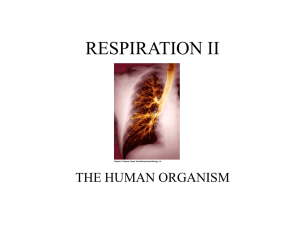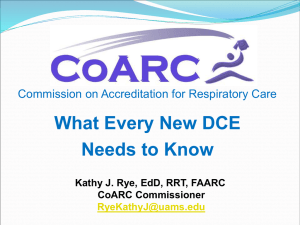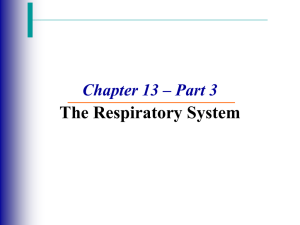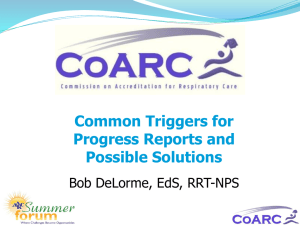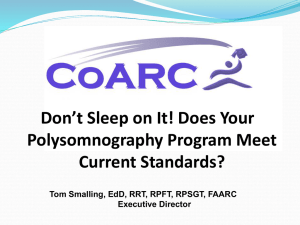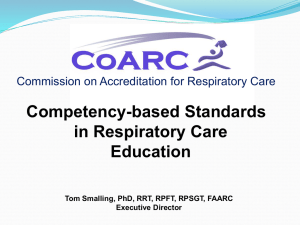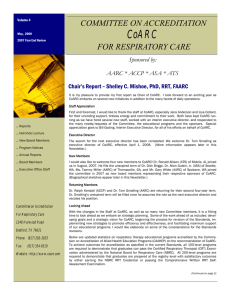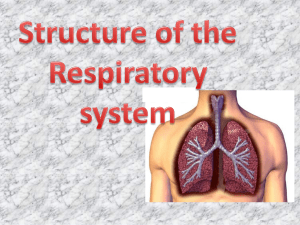Quality Assurance in the PFT Lab - Committee on Accreditation for
advertisement
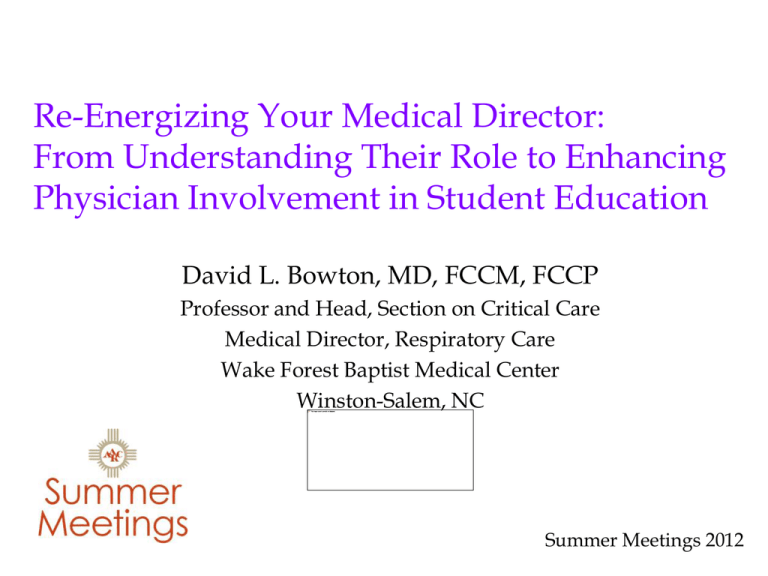
Re-Energizing Your Medical Director: From Understanding Their Role to Enhancing Physician Involvement in Student Education David L. Bowton, MD, FCCM, FCCP Professor and Head, Section on Critical Care Medical Director, Respiratory Care Wake Forest Baptist Medical Center Winston-Salem, NC Summer Meetings 2012 Conflict of Interest I have no real or perceived conflict of interest that relates to this presentation. Any use of brand names is not in any way meant to be an endorsement of a specific product, but to merely illustrate a point of emphasis. Summer Meetings 2012 Objectives Learning objectives for this presentation: • The learner will be able to describe the roles and responsibilities of the Medical Director as they relate to the CoARC Standards • The learner will be able to discuss strategies to enhance the involvement of the Medical Director and other physicians in their students’ educational activities Summer Meetings 2012 CoARC Standards • • • • Standard 2.03 - The sponsoring institution must appoint, at a minimum, a full-time Program Director, a full-time Director of Clinical Education, and a Medical Director. Minimal evidence of compliance associated with this Standard: a. Documentation of Employment; b. Academic Catalog; c. Written job descriptions including minimal qualifications for key program personnel. Interpretive Guideline: Full-time is defined as a qualified paid employee of an institution to teach specific content in the respiratory care curriculum who holds an appointment that is considered by that institution to constitute full-time service. Full-time faculty includes all persons who are employed full-time by the institution, who are appointed primarily to the respiratory care program, and whose job responsibilities include teaching, regardless of the position title (e.g., full-time instructional staff and clinical instructors would be considered faculty). The length of the full-time appointment (e.g., 10month, 12-month, etc.) must be sufficient to allow the Program Director and Director of Clinical Education the ability to carry out their responsibilities as identified in 2.04 and 2.09, respectively. The Medical Director and any co-Medical Directors are not required to have full-time appointments. CoARC Standards • • • • Standard 2.14 - The program must appoint a Medical Director to provide and ensure direct physician interaction and involvement in student education in both the clinical and nonclinical settings; the Medical Director must be a Board certified, licensed physician, credentialed at one of its clinical affiliates, with recognized qualifications, by training and/or experience, in the management of respiratory disease and in respiratory care practices. Minimal evidence of compliance associated with this Standard: a. Curriculum Vitae; b. Appointment Letter/Contractual Agreement; c. Schedules of physician teaching interaction with students; d. Results of annual program resource assessment as documented in the CoARC resource assessment matrix. Interpretive Guideline: The Medical Director supports the Program Director and Director of Clinical Education in ensuring that both didactic instruction and supervised clinical practice experiences meet current practice standards as they relate to the respiratory therapists role in providing patient care. The Medical Director should be a member of the Advisory Committee. CoARC Standards • • • • Standard 3.12 - Programs must assess their outcomes annually, using standardized CoARC surveys of employers, faculty, students and graduates. Minimal evidence of compliance associated with this Standard: a. Hard copy or electronic records of completed CoARC survey instruments; b. Results of annual Report of Current Status submitted to CoARC. Interpretive Guideline: CoARC expects results of annual, ongoing self-assessment to include the Student-Program and Personnel-Program Resources Surveys as well as the Graduate and Employer Surveys (available at www.coarc.com). The program should provide an analysis and action plan to address deficiencies identified from these surveys. The program should also conduct a selfanalysis of student evaluations for each course and rotation, student evaluations of faculty, failure rates for each course and clinical rotation, student remediation, student attrition, and faculty evaluations of students’ preparedness for rotations. CoARC Standards • • • • Standard 4.06 - Respiratory Care content must include respiratory care of the adult, pediatric, and newborn patient, health promotion, education, and disease management; fundamental principles of healthcare reimbursement; fundamental principles of evaluating current scientific literature; medical ethics; provision of health care services to patients with transmissible diseases; provision of services for and management of patients with special needs; community respiratory health; medical emergencies; and legal and ethical aspects of respiratory care practice. Minimal evidence of compliance associated with this Standard: a. Course syllabus for all respiratory care courses which include course description, learning goals, objectives, methods of evaluation, content outline, and criteria for successful course completion. Interpretive Guideline: Professional content areas provide the knowledge base in respiratory care and prepares the student to assess, plan, implement and evaluate respiratory care services as an integral member of the health team. CoARC Standards • • Standard 4.07 - Curricular content in respiratory care must be periodically reviewed and revised to ensure its consistency with the competencies and duties performed by registered respiratory therapists in the workforce, as established by the national credentialing agency through its periodic job analysis and credentialing examination specifications. For the polysomnography option, curricular content must be periodically reviewed and revised to ensure its consistency with the competencies and duties performed by sleep disorder specialists in the workforce, as established by the national credentialing agency through its periodic job analysis and outlined in its credentialing examination specifications. These nationally accepted standards provide the basis for formulating the objectives and competencies of the program’s curriculum. A review of the curricular content must be conducted after any revision in the credentialing examination specifications. Minimal evidence of compliance associated with this Standard: a. Course syllabi for all respiratory care courses which include course description, learning goals, objectives, methods of evaluation, content outline, criteria for successful course completion; b. Written documentation of the comparison of the program curriculum to the most current credentialing exam specifications; c. Annual Report of Current Status submitted to CoARC documenting program outcomes on credentialing examinations. CoARC Standards • Standard 4.07 Interpretive Guideline: • Respiratory Care curricular content should reflect the current competencies and duties required of registered respiratory therapists. Respiratory therapists provide patient care which includes clinical decision-making and patient education. The respiratory care scope of practice includes, but is not limited to the following basic competencies: • acquiring and evaluating clinical data; • assessing the cardiopulmonary status of patients; • performing and assisting in the performance of prescribed diagnostic studies such as: obtaining blood samples, blood gas analysis, pulmonary function testing, and polysomnography; • evaluating data to assess the appropriateness of prescribed respiratory care; • establishing therapeutic goals for patients with cardiopulmonary disease; • participating in the development and modification of respiratory care plans; • case management of patients with cardiopulmonary and related diseases; • initiating prescribed respiratory care treatments, managing life support activities, evaluating and monitoring patient responses to such therapy and modifying the prescribed therapy to achieve the desired therapeutic objectives; • initiating and conducting prescribed pulmonary rehabilitation; • providing patient, family, and community education; • promoting cardiopulmonary wellness, disease prevention, and disease management; and • promoting evidence-based practice by using established clinical practice guidelines and by evaluating published research for its relevance to patient care. CoARC Standards • • • • • • Standard 4.08 - Graduates must be competent in interpersonal and communication skills to effectively interact with diverse population groups. Minimal evidence of compliance associated with this Standard: a. Documentation of relevant course content; b. CoARC employer surveys. Interpretive Guideline: Quality health care education involves an ongoing consideration of the constantly changing health care system and the impact of racial, ethnic and socioeconomic health disparities on health care delivery. Instruction related to medical care and diversity prepares students to evaluate their own values and avoid stereotyping. It assists them in becoming aware of differing health beliefs values and expectations of patients and other health care professionals that can affect communication, decision-making, compliance and health outcomes. Students should be able to effectively communicate with individuals and groups. The ability to communicate verbally and in written form is basic to the provision of respiratory care services in a safe and effective manner. CoARC Standards • • • • Standard 4.09 - Graduates must be competent in the application of problem solving strategies in the patient care setting. Minimal evidence of compliance associated with this Standard: a. Summary of course evaluation mechanisms designed to evaluate the student's ability to apply knowledge, perform appropriate patient care, solve problems, and demonstrate appropriate behavior; b. Results of CoARC employer satisfaction surveys. Interpretive Guideline: Critical thinking is defined as active and reflective reasoning that integrates facts, informed opinions and observations. Critical thinking and decision making skills are necessary to provide effective and efficient respiratory care services. Programs should provide evidence of the methods used to assess, as well as provide feedback for, the development of the student’s critical thinking skills and problem solving abilities. Yeah, But How do I DO This? • Regular physician contact • Does NOT have to be with Medical Director • USE the Medical Director to get OTHER physicians • Make it a painless expectation • In the ICU: Find out the schedule – have students there • Invite physicians for SPECIFIC topics 1 hour – no more • Location: Consider having lectures in the hospital?? Make it Easy • Provide specific topics and expectations • It does NOT make it easier to let them do what they think needs to be covered • Curricular expectations are HUGE! • There is no shortage of topics • Ask around – find out what docs like to talk about what topics Specific Topics • Case presentations • Virtually no RT grad is comfortable presenting a patient to a physician • Why? • They do not get sufficient practice or guidance • Use multiple physicians if possible • There is no “one right way” to present • But there are common avoidable mistakes • Get students comfortable with this Specific Topics • Communication • SBAR • Situation • Background • Assessment • Recommendation • This can be readily modified but basic components remain unchanged: • Brevity, Clarity, Specificity • Unapologetic, Professional, Knowlegable Specific Topics • Clinical Controversies • This is the “key” to evidence based medicine • There is virtually no certainty in medicine • What I “know” today will likely be tossed in 5 years • Know the shortcomings of evidence • Understand how to evaluate the limitations of studies • Presenting clinical controversies helps students get comfortable with differing opinions and how to “argue” their viewpoint and lessen their emotional attachment to “winning” • Can be two docs with differing viewpoints Specific Topics • How to interact effectively as part of a team • Rounding in the hospital other disciplines • Speaking up without acting out Specific Topics • Clinical updates • View students as potential colleagues of Medical Director • Their knowledge helps provide better care for their patients Increase Professionalization • Involve in committees or task forces • Encourage engagement with AARC and state societies • Help them understand their role in increasing the value of RRTs in healthcare in general • Continuing education – keeping up to date – is an expectation of professionals • Journal reading • Expecting RRT credentialing (and more) Conclusions • YOU are the experts in RT Education • YOU know what your students need • But listen to others regarding any weaknesses in your students’ skill sets • Provide your Medical Director with SPECIFIC guidance • Give them specific feedback on their performance • Solicit honest feedback from them
